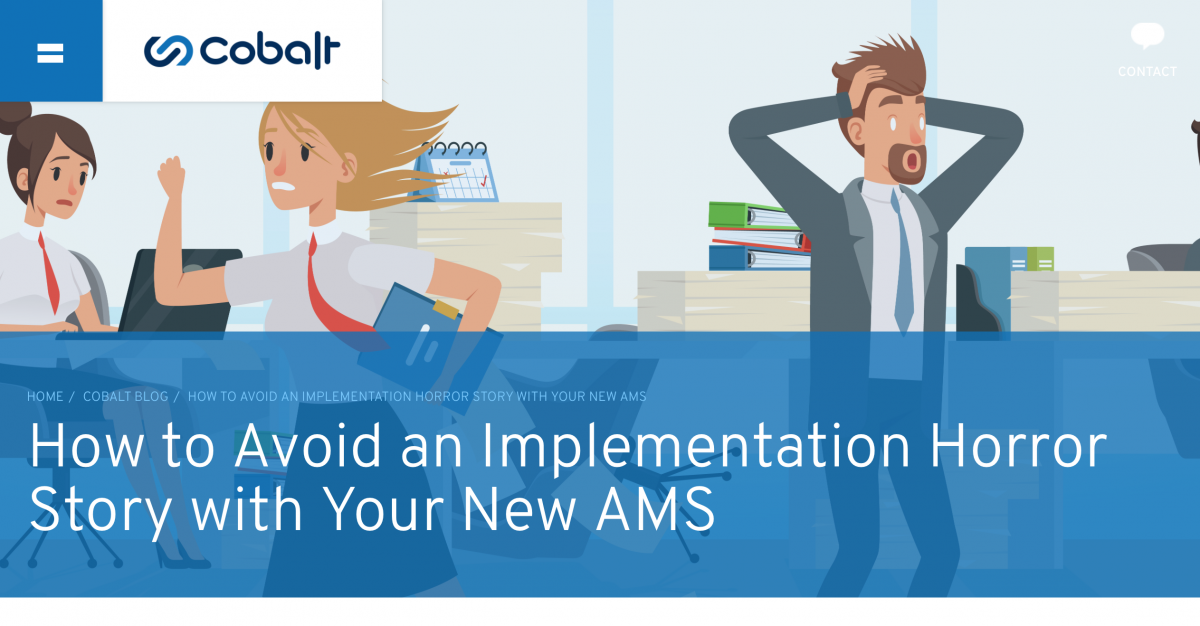
Guest post by Chris Capistran, President - Cobalt
There are three ways adopting a new AMS or CRM can turn into the painful or frustrating micro-calamity that makes you want to never go through it again...
- The search process can drag on, get short-circuited, suck up a bunch of time and effort, and still not leave you confident in your choices. Or, you know, any combination of these things.
- The implementation can spiral out of control with a blown budget or timeline, stir up all kinds of dissension in your ranks, lead to a loss of data or functionality, and more.
- If one or both of these earlier stages haven’t gone well, you’re likely going to have some further problems after implementation as your staff and customers adapt to the new way of doing things.
I’m not trying to be an alarmist or melodramatic, but our team at Cobalt has seen significant challenges for clients at each of these stages. One of the reasons our long-standing client partners value us is because we help them avoid or mitigate the pain and problems along the way.
So, today I’m going to briefly break down four fictional scenarios that reflect different real-life scenarios we have encountered to illustrate how implementation can turn into a real horror story for your organization. You’ll get a dialed-in summary of the issues that cause problems, and concrete advice for avoiding these pitfalls. Let’s walk through some problems and solutions.
Scenario #1: A Universe of Possibilities
Wouldn’t it be amazing if our new AMS could do the following 450 things? Every one of our major stakeholders and key team players is angling to have their pet feature included. We’ve been building this list for 10 years and now is our chance to do everything!
The Problem:
In this situation, an organization’s ideal, perfect expectations can crush the plan for implementation because you cannot implement every great idea at one time.
The Takeaways:
You know how decisiveness creates project momentum, and analysis paralysis destroys it! As you and your team are thinking big and planning for your next adoption, don’t let great get in the way of good. Take some of your great ideas and dedicate them to your next release — you’ll save planning time in the future, and free up resources for making the great ideas in this release even stronger.
Also, commit to making a project charter before implementation. It is such a helpful, guiding resource for keeping everyone clear about the plan and expectations. These have been invaluable to the Cobalt team and our partners.
Scenario #2: When Busyness Can Hurt Your Business
How important is this CRM implementation? Well, it’s going to impact the daily productivity and effectiveness of our entire staff and have a massive impact on how our members view our association and interact with us. So, I mean, we’re busy, but I’d still say this implementation is a top priority for us. What kind of resources have we dedicated to it? Well, we’ve got a whole half-day blocked off for the staff to get up to speed and trained on the basics. Plus, Todd and Susan have a few hours scheduled to tie up any loose ends.
The Problem:
Implementation projects fail when they don’t have enough quality time dedicated to them.
The Takeaways:
You don’t have to go overboard in setting aside time and resources for implementation. It doesn’t need to take over your organization and your other priorities. However, don’t let that lead you to shortchange what resources you’re allocating for this phase, either.
You need adequate time from both key stakeholders and your whole staff for this to be a success. Cobalt tells its customers to budget 20% of whatever time we spend. So, if we’re spending 1,000 hours, you’ll need to carve out at least 200 hours to be successful. Make it quality time, while you’re at it! The more you can schedule blocks of time, the better. Dedicated time is much better than trying to squeeze testing and feedback in between other meetings and calls. At Cobalt, we even offer to host our clients at our offices for “war room” testing. Getting away from your day-to-day and focusing on the task at hand makes a huge difference. Plus, we provide food and drinks.
The single most important thing I can advise you on this front is to make sure the executives champion this project. If you start there and maintain that visible support, it will solve untold numbers of potential implementation headaches.
Scenario #3: There Was a Grumbling Among Them …
Well, no. Not everybody was onboard with the new system. Most of the major team leaders seemed okay to move forward, though, with just a couple of sharp disagreements. Everybody that needed to know what direction we were headed was pretty much giving it the green light. We thought about doing some user testing with our customers, but in the end, it just wasn’t feasible to organize that with everything else we had going on.
The Problem:
If you don’t have internal consensus and customer buy-in, your system won’t get used, and there will be resentment, frustration, or both.
The Takeaways:
Survey your staff and let them know you’ve heard, understood, and captured the parts of their processes and workflows that they need to do their jobs. Schedule meetings with critical stakeholders and your new vendor so everyone can voice any questions or concerns before the implementation work begins. Don’t ignore or overlook key stakeholders that aren’t engaging in the preparations for this transition.
Also, getting feedback from your existing members or customers can be incredibly helpful. Just as you need executive champions to pave the way internally, some key advocates from your end-users will sometimes create a groundswell of goodwill and excitement about the change that comes with a new system.
Finally, I would say you need some internal walkthroughs and training demonstrations led by seasoned subject matter experts. Trust me, and trust the Cobalt team’s 20 plus years of helping organizations get up to speed on a new system — those walkthroughs will make or break your implementation.
Scenario #4: Having (All 15 of) Your Ducks in a Row
Things might be tight or a bit crazy for a little while, but if we reassign some tasks and shuffle our resources around, we should have pretty much what we need to make this implementation happen alongside our website overhaul. And getting our new accounting system in place. And upgrading everything else while we’re at it. We’ve got a resourceful team, and we’ll find a way to get it all done!
The Problem:
When you split your focus between major projects happening concurrently, all projects suffer.
The Takeaways:
Cobalt is like your organization and every team trying to maximize productivity — we want to work efficiently and effectively. Also, we encourage strategic timing and plans for scheduling your next implementation. There are some great times to slot this project in your calendar, such as just after your big annual conference, or when you are three months ahead of running your annual dues.
Not overlapping major projects is one key to getting the most out of your investments in both cases. As you’re talking about implementation possibilities with your vendor, make sure you break out your project calendar so everyone can see the other priority tasks to work around.
The Best Implementation Starts With the Best Search Process and Plan
Over the years, the vast majority of Cobalt’s implementation projects have gone as well as anyone could hope. By the time we get to implementation, we’ve got such an excellent groundwork and communication channel established that we can work through the inevitable unforeseen challenges with a significant, dynamic implementation project.
We work hard to make sure there’s a good fit with our clients, and we’re transparent each step of the way — if there’s a trick or best practice we’ve unearthed in previous projects, you’ll have the benefit of that with our team. We’ve also invested a tremendous amount of energy in helping associations make the most of the search process because that helps you, us, and the project! Read more about that in our Definitive Guide to Choosing a New AMS/CRM for Your Association.
Learn More
Want to learn more? We’ll try not to spook you too much, but it’s that time of the year! We have a few scary stories to tell you about how you can avoid implementation nightmares. Join us on Wednesday, October 30th at 1:00pm CT for AMS Implementation Horror Stories where we’ll be focusing on how to avoid AMS implementation pitfalls, so you can survive to tell your story. This free webinar will be moderated by Teri Carden, Founder of ReviewMyAMS and presented by Chris Capistran, President of Cobalt.
Don't be afraid of implementation nightmares.... Register now!
